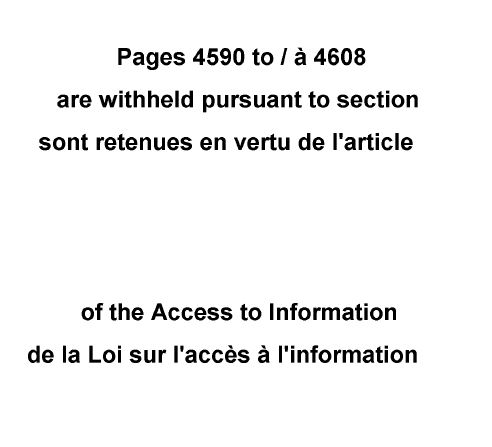Thousands of pages of correspondence and briefing notes on the federal government’s anti-terror Bill C-51 are so secret the government won’t disclose its reasons for censoring them.

In April, Global News requested documents from Public Safety Canada relating to the constitutionality of Bill C-51, passed earlier this year.
READ MORE: Are you already violating feds’ anti-terror bill?
The bill’s proponents point to attacks last fall on Canadian soil and the Islamic State’s global expansion as urgent factors indicating Canada’s need for new laws.
The bill has been criticized by security experts and civil liberties advocates alike for violating the Charter of Rights and Freedoms without taking steps to improve intelligence-gathering or make Canadians safer. It faces a constitutional court challenge.
Global News was interested in the constitutional argument in favour of the bill, and while we knew legal advice (among other things) is exempt from freedom-of-information requests, we wanted to inform Canadians of the rationale behind this piece of legislation.
‘C-51 is a tragedy’: New book slams Canada’s anti-terror law
The federal Conservatives say the bill’s necessary to keep Canada safe in a volatile environment of evolving terror threats and international radicalization. The Liberals, who voted for the bill, say they’d amend it and add sunset clauses. The NDP, which voted against the bill, has pledged to repeal it.
In response to the access-to-information request Global News received three CDs with pdf documents containing more than 4,600 pages of speeches, briefing notes, transcripts and summaries of committee meetings, public and media queries and extensive correspondence within Public Safety and between government departments.
Enormous amounts of these documents are censored, including the body text of emails and the names of attachments. Many pages are redacted in their entirety.
- Budget 2024 failed to spark ‘political reboot’ for Liberals, polling suggests
- Train goes up in flames while rolling through London, Ont. Here’s what we know
- Peel police chief met Sri Lankan officer a court says ‘participated’ in torture
- Wrong remains sent to ‘exhausted’ Canadian family after death on Cuba vacation
And the government can’t tell us why.
READ MORE: On terror rhetoric, Public Safety Minister ignores RCMP and his own advisors
As a rule, redactions in access-to-information documents are accompanied by references to the law permitting their redaction. (For example, a partially blacked-out page marked 20(1)(b) means it was censored because it contains a third party’s financial or commercial information.)
Not so in this case:

The cover letter of the most recent installment, received this week, cites 14 sections of the Access to Information Act. But we don’t know which of those sections pertain to what censored sections.
Revealing the reason for censoring bits of documents could reveal what those documents are about, she said.
“In the records that are involved in the file, there’s national security-type information. So there is an injury, with stamping the records, as there’s an increased likelihood of revealing the content. … Kind of like putting a puzzle back together.”
Having this information is important not only because it makes it possible to challenge redactions, but because it ensures public documents aren’t being censored arbitrarily.
Federal Information Minister Suzanne Legault has raised concerns in the past about the leeway government departments have in picking reasons to censor information.
“The current act contains so many exclusions and exemptions, it has become a how-to guide to deny disclosure,” she said in March.
DUTY TO DOCUMENT: What you need to know about access-to-info reform
“I’m hard pressed to understand the logic of exempting something on national security grounds, refusing to indicate on paper a national security exemption,” said University of Ottawa law professor Craig Forcese, who along with the University of Toronto’s Kent Roach wrote a book about Canada’s newest terror law.
“At the end of the day, there are some documents that clearly can’t be disclosed,” Forcese said.
Forcese argues there are cases when a lack of transparency and communication can make Canadians less safe, not more so — now-notorious failures in communication contributed to both the Air India bombing and Maher Arar’s detention and torture in Syria, Forcese said.
“If you’re too wary in how much info you share, it can have counterproductive security implications,” he said.
“Foreign observers, when they look at our system, they shake their heads.”
‘Inaccurate’ talking points
What we can read in the documents provides a window into public servants struggling to answer questions about the anti-terror bill after it was unveiled earlier this year.
In a series of emails in February, responding to a media request about the new powers the bill would give Canada’s spy agency, a CSIS member expressed concern a list of government-approved talking points is incorrect — and left out one of the more contentious aspects of C-51, which gives CSIS the ability to act without judicial authorization.
“The response seems inaccurate,” she writes.
“What’s missing from the answer is that the Bill allows CSIS to take lawful measures, without a warrant.”
“Legislation demands that we be extra prudent,” she writes.
“I realize you’re taking already approved lines but when it comes to this topic, as we’ve just seen, they don’t really answer the questions or are sometimes not accurate.”






Comments